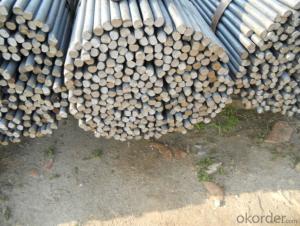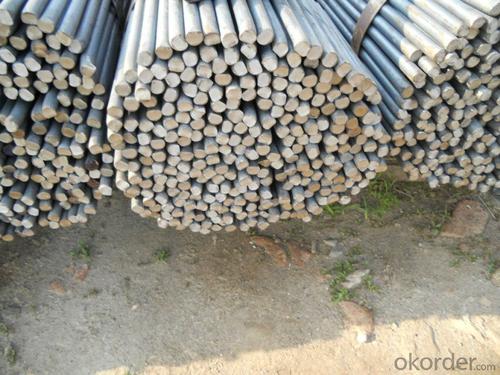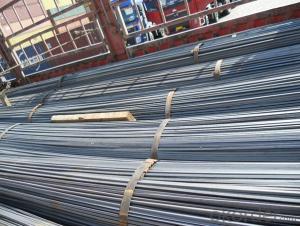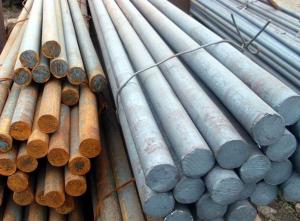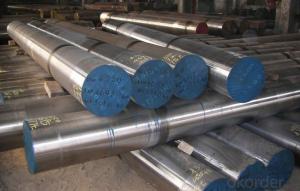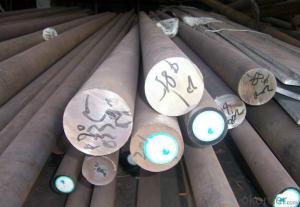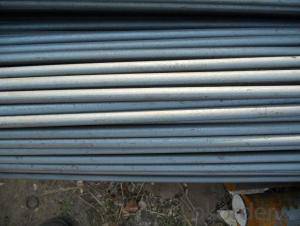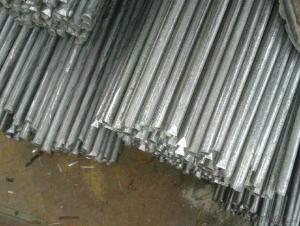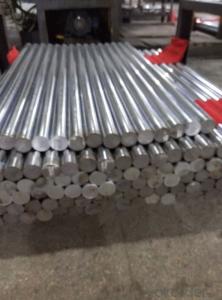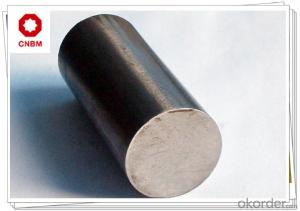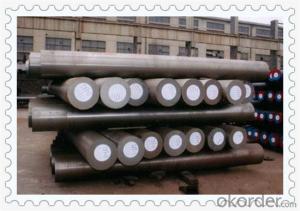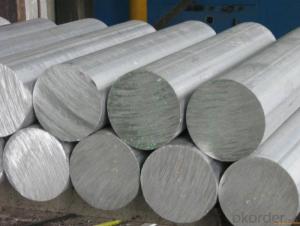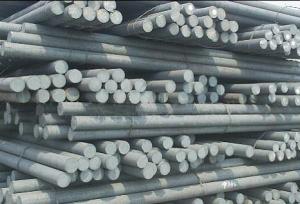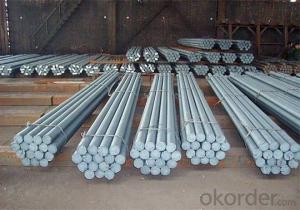Round Bar Chromed Steel Round Bar-Steel Round Bar SS400
- Loading Port:
- Tianjin
- Payment Terms:
- TT OR LC
- Min Order Qty:
- 25 m.t.
- Supply Capability:
- 20000 m.t./month
OKorder Service Pledge
OKorder Financial Service
You Might Also Like
Specification
Product Description:
OKorder is offering High quality Round Bar Chromed Steel Round Bar-Steel Round Bar SS400 at great prices with worldwide shipping. Our supplier is a world-class manufacturer of steel, with our products utilized the world over. OKorder annually supplies products to European, North American and Asian markets. We provide quotations within 24 hours of receiving an inquiry and guarantee competitive prices.
Product Applications:
Round Bar Chromed Steel Round Bar-Steel Round Bar SS400 are ideal for structural applications and are widely used in the construction of buildings and bridges, and the manufacturing, petrochemical, and transportation industries.
Product Advantages:
OKorder's Round Bar Chromed Steel Round Bar-Steel Round Bar SS400 are durable, strong, and resist corrosion.
Main Product Features:
· Premium quality
· Prompt delivery & seaworthy packing (30 days after receiving deposit)
· Corrosion resistance
· Can be recycled and reused
· Mill test certification
· Professional Service
· Competitive pricing
Product Description:
Specifications of High Quality Round Bar
1. Grade: GB, JIS, ASTM, EN
2. Grade: Q235, SS400, A36, S235JR
3. Diameter and mass: As below
Diameter | Mass | Diameter | Mass | Diameter | Mass |
(mm) | (kg/m) | (mm) | (kg/m) | (mm) | (kg/m) |
6 | 0.22 | 22 | 2.98 | 53 | 17.30 |
7 | 0.30 | 24 | 3.55 | 56 | 19.30 |
8 | 0.40 | 25 | 3.85 | 60 | 22.20 |
9 | 0.50 | 26 | 4.17 | 63 | 24.50 |
10 | 0.62 | 28 | 4.83 | 65 | 26.00 |
11 | 0.75 | 30 | 5.55 | 70 | 30.20 |
12 | 0.89 | 32 | 6.31 | 75 | 34.70 |
13 | 1.04 | 34 | 7.13 | 80 | 39.50 |
14 | 1.21 | 36 | 7.99 | 85 | 44.50 |
15 | 1.39 | 38 | 8.90 | 90 | 49.90 |
16 | 1.58 | 40 | 9.86 | 95 | 55.60 |
17 | 1.78 | 42 | 10.90 | 100 | 61.70 |
18 | 2.00 | 45 | 12.50 | 120 | 88.85 |
19 | 2.23 | 48 | 14.20 | 140 | 120.93 |
20 | 2.47 | 50 | 15.40 | 150 | 138.82 |
4. Material: Mild Steel
5. Heat treatment of high quality steel:
Fire: Isothermal annealing temperature is 800 ~ 880 °C, with 10 ~ 20 °C, the furnace cooling to about 600 °C, hardness above HB269.
Preheat temperature: 730-730 °C
Quenching temperature: 1190-1210 °C
Tempering temperature: 540-595 °C
Cold drawn, hardness 285 HBS
Cold drawn after annealing condition, hardness 277 HBS
Quenching methods: oil quenching, air cooling or salt bath quenching
Production Flow of High Quality Round Bar
The common processes are preheated forging quenching, dual refinement solution process, cooling quenching and isothermal quenching. We use heat treatment for dual refinement solution process. The main measures process is high temperature solution and refinement cycle. High temperature solution can improve the carbide morphology and particle size. The aim is to make the loop refinement ultrafine austenite grains.
FAQ:
Q1: Why buy Materials & Equipment from OKorder.com?
A1: All products offered byOKorder.com are carefully selected from China's most reliable manufacturing enterprises. Through its ISO certifications, OKorder.com adheres to the highest standards and a commitment to supply chain safety and customer satisfaction.
Q2: How do we guarantee the quality of our products?
A2: We have established an advanced quality management system which conducts strict quality tests at every step, from raw materials to the final product. At the same time, we provide extensive follow-up service assurances as required.
Q3: How soon can we receive the product after purchase?
A3: Within three days of placing an order, we will begin production. The specific shipping date is dependent upon international and government factors, but is typically 7 to 10 workdays.
Images:
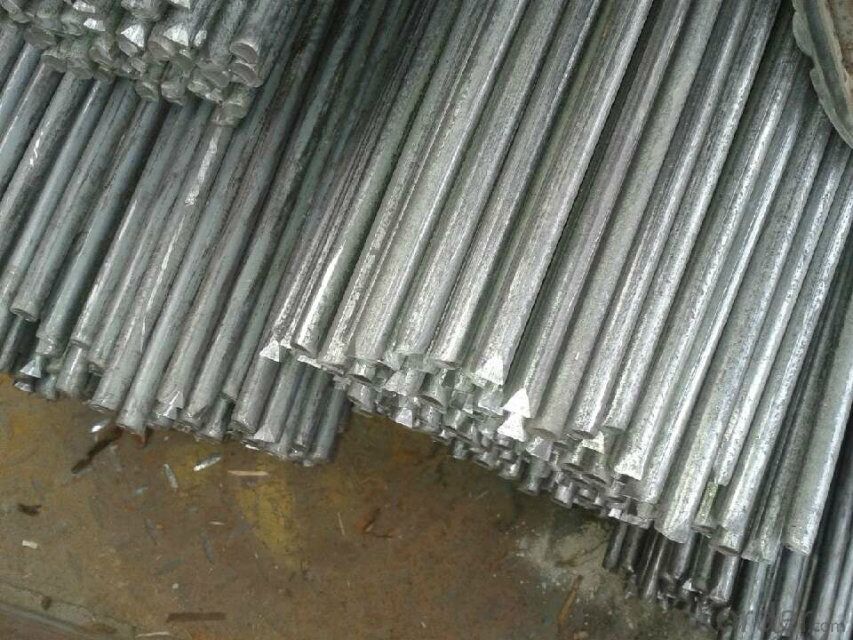

- Q: What are the factors affecting the price of steel round bars?
- There are several factors that can affect the price of steel round bars. Some of the key factors include the cost of raw materials used in steel production, such as iron ore and coal. Additionally, factors such as global supply and demand, market competition, and economic conditions can also influence the price of steel round bars. Other factors like transportation costs, energy prices, and government regulations can also play a role in determining the final price of steel round bars.
- Q: How many roots are there in a standard ton of steel and how many meters are there in a steel bar?
- The general drawing bar is 6 meters, some ribbed bars 9 meters and 12 meters two tons of steel; a number of roots can not say, can be 1 or 100 roots, the length of thickness do not know how to tell you how many tons of reinforced root ah.
- Q: Can steel round bars be threaded?
- Yes, steel round bars can be threaded. Threading refers to the process of cutting threads onto the surface of a cylindrical object, such as a steel round bar, to create a screw-like shape. This allows the bar to be securely fastened into a corresponding threaded hole or to join with another threaded component. Threading can be done using different methods, such as manual threading with a die or using machine tools like lathes or thread rolling machines. The specific method used depends on the size and type of thread required. However, it is important to note that not all steel round bars are suitable for threading, as the material composition and hardness of the steel can affect the threading process. Therefore, it is recommended to consult with a professional or experienced personnel to ensure the steel round bar is suitable for threading and to determine the appropriate threading method.
- Q: What are the advantages of using chromium-alloy steel round bars?
- There are several advantages to using chromium-alloy steel round bars. Firstly, the presence of chromium in the alloy significantly enhances the corrosion resistance of the steel, making it ideal for applications in harsh environments or exposed to corrosive substances. Additionally, chromium-alloy steel round bars offer excellent strength and hardness, making them suitable for heavy-duty applications that require high load-bearing capacity. The inclusion of chromium also improves the steel's heat resistance, allowing it to withstand high temperatures without losing its structural integrity. Lastly, chromium-alloy steel round bars are known for their excellent wear resistance, making them a reliable choice for industries such as automotive, construction, and manufacturing.
- Q: The problem of dowel bars on concrete pavements?
- The dowel bar is arranged according to the transverse contraction joint and expansion joint set, meaning that a transverse contraction joint and expansion joint place dowels, are not plate must be set. In general, each 200m set a expansion joint, or other road intersection, and bridge connecting point must be set up.
- Q: What is the typical yield strength of a steel round bar?
- The typical yield strength of a steel round bar can vary depending on the specific grade of steel used. However, for most common grades of steel, the yield strength typically falls within the range of 36,000 to 80,000 pounds per square inch (psi). It is important to note that this range is a general guideline, and there are exceptions and variations among different grades of steel. Additionally, factors such as the manufacturing process and any additional treatments or heat treatments applied to the steel can also impact its yield strength. Therefore, it is always advisable to consult the specific material specifications or consult with a metallurgical expert for accurate and precise information regarding the yield strength of a particular steel round bar.
- Q: What are the applications of steel round bars?
- Due to their inherent strength, durability, and versatility, steel round bars find extensive applications across various industries. They play a crucial role in: 1. Construction: Steel round bars are widely used in the construction industry for structural purposes. They provide stability and safety in building columns, beams, and frames due to their high strength-to-weight ratio. 2. Manufacturing: The manufacturing sector heavily relies on steel round bars for fabricating components and machinery. They are essential in producing gears, shafts, axles, and other machine parts that demand precision and strength. 3. Automotive industry: Steel round bars are significant in manufacturing crankshafts, connecting rods, suspension components, and other automobile parts. They contribute to the strength and reliability of vehicles. 4. Oil and gas industry: The oil and gas sector utilizes steel round bars in manufacturing drill bits, valves, pipes, and equipment exposed to harsh environmental conditions. These bars offer high strength and corrosion resistance. 5. Aerospace industry: The aerospace industry heavily depends on steel round bars for their high strength and lightweight properties. They are used in aircraft components such as landing gear, engine parts, and structural elements. 6. Shipbuilding: Steel round bars are commonly employed in shipbuilding due to their excellent strength and corrosion resistance. They are used in constructing ship frames, hulls, and critical components that require durability in harsh marine environments. 7. Infrastructure projects: Steel round bars are extensively used in infrastructure projects like bridges, tunnels, and railways. They provide the necessary strength and stability to support heavy loads and ensure the structural integrity of these projects. 8. Furniture and interior design: Steel round bars also find applications in the furniture and interior design industry. They are commonly used in the construction of chairs, tables, shelves, and other furniture pieces due to their sleek appearance, durability, and ease of molding. In conclusion, steel round bars have a wide range of applications in various industries, contributing to the development of robust and reliable structures, machinery, and equipment.
- Q: What are the advantages of using nickel-chromium alloy steel round bars?
- Using nickel-chromium alloy steel round bars in various applications offers several benefits. Firstly, these round bars possess outstanding corrosion resistance properties. The inclusion of nickel and chromium elements in the alloy enhances its ability to withstand corrosion from moisture, chemicals, and oxidation, making it suitable for use in challenging environments like marine applications, chemical processing plants, and oil refineries. Secondly, these round bars exhibit high temperature resistance. The combination of nickel and chromium in the alloy allows it to endure elevated temperatures without compromising its structural integrity. This makes them ideal for use in heat exchangers, furnaces, and other high-temperature applications. Furthermore, these round bars boast exceptional mechanical properties. They demonstrate excellent strength, toughness, and wear resistance, making them ideal for applications that require high load-bearing capabilities. Additionally, they exhibit good ductility, enabling easy machining and fabrication. Additionally, these round bars possess good electrical conductivity, making them suitable for electrical and electronic applications where conductivity is crucial, such as in the manufacturing of resistors, heating elements, and electrical connectors. Lastly, these round bars are readily available and cost-effective. Being a widely used material in various industries, they are easily accessible and can be obtained at competitive prices. In conclusion, the advantages of utilizing nickel-chromium alloy steel round bars encompass excellent corrosion resistance, high-temperature resistance, superior mechanical properties, good electrical conductivity, and cost-effectiveness. These characteristics make them the preferred choice for a wide range of applications in industries such as construction, automotive, aerospace, and electrical engineering.
- Q: Can steel round bars be used for making tie rods?
- Yes, steel round bars can be used for making tie rods.
- Q: What are the typical price ranges for steel round bars?
- The typical price ranges for steel round bars can vary depending on various factors such as the type of steel, the diameter, length, and the quantity being purchased. Generally, steel round bars can range in price from $1 to $5 per foot for common carbon steel grades. However, specialty and high-grade steel round bars can be priced higher, ranging from $5 to $20 per foot or even more. Additionally, larger diameter or longer length steel round bars may also be priced higher due to increased material and manufacturing costs. It is important to note that these price ranges are approximate and can vary based on market conditions, supplier pricing, and other factors. To get an accurate price range, it is recommended to contact steel suppliers or distributors for specific quotes based on your requirements.
Send your message to us
Round Bar Chromed Steel Round Bar-Steel Round Bar SS400
- Loading Port:
- Tianjin
- Payment Terms:
- TT OR LC
- Min Order Qty:
- 25 m.t.
- Supply Capability:
- 20000 m.t./month
OKorder Service Pledge
OKorder Financial Service
Similar products
Hot products
Hot Searches
Related keywords
